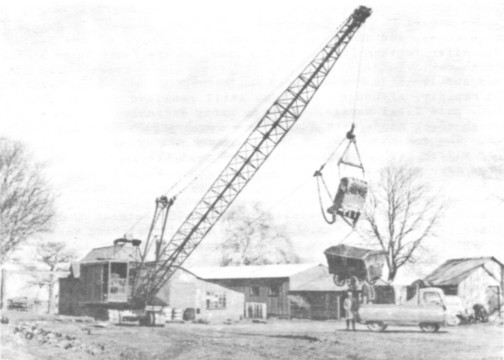
| THE INDUSTRIAL RAILWAY RECORD |
© NOVEMBER 1962 |
IRONSTONE TRAMWAYS
OF THE MIDLANDS
The first edition of the above book detailed the known history of the various systems up to the end of 1957. In the 1961 revised edition are given important changes that have occurred since that date, and also amendments to earlier history where fresh facts have been brought to light. These changes have been incorporated in the text without any major alteration of layout or pagination. The aim of the articles in the present series is to provide more detailed accounts of events not covered by the first edition, either in the form of recent happenings on selected systems or additional information of historical interest. It is aimed to make each article complete in itself, yet for it to be read in conjunction with the original material. The order of articles will be governed solely by availability of data.
The first article, describing the eclipse of the narrow gauge in Leicestershire, is derived almost entirely from the reports of Section members and is a striking example of the value of cooperative effort in making a connected story. The writer’s warm thanks are due to all those members whose notes form the basis of this narrative.
(1) TWILIGHT IN BELVOIR by ERIC S. TONKS
Eaton Quarries (“Waltham”)
1958 was a year of depression in the iron-ore industry, and nearly all quarries suffered short-time working or periods of closure. “Waltham” (to use its familiar name) with its relatively small output and greater distance of haulage to the furnaces, was one of the first to feel the axe and was closed in February 1958 - “temporarily” to quote the local Press. The men were found work in other nearby quarries. There was some talk of reopening with road haulage, but nothing was done in this direction and later events would seem to rule out revival in any form.
The working locomotives, CAMBRAI and DREADNOUGHT, were greased up and locked in the shed. NANTES, already withdrawn, was left outside on the bank to the tipplers. Silhouetted amongst the trees, her typical French outline presented a most unusual spectacle to the casual passerby - but she was familiar enough to the enthusiasts who flocked to “Waltham”, which was probably the most picturesque of the remaining narrow gauge ironstone lines.
In May the burners arrived, but they did nothing beyond cutting up a few of the “trains” which had been keeping THE BARONET company down the line, and then decamped. Road trimmers severed the rail at the level crossing in the same month, but for the next twelve months nothing was touched; a little sugar beet traffic used the tipping dock which was otherwise deserted. A fence was placed across the track between NANTES and THE BARONET; a bush sprouted between the latter’s frames, and weeds grew over her till in April she was described as being in “absolutely shocking condition” In August 1959 track lifting by road vehicles commenced, and by December all track had been lifted from Knipton right back to the level crossing near the shed. Some rail was sold to the Hoveringhan Gravel Co. Ltd., and some to Richard Thomas & Baldwin’s Irthlingborough quarries, and this was sent away in lorries of the Syston Haulage Company. After further lifting of the track to the fence below NANTES, a halt was made to restore the ground to its original contours where the tramway traversed arable land. One tippler was cut up by July, and wagons were being scrapped rapidly, although sixty-one still remained on 28th June 1960 when the B.L.C. paid final homage. A large party assembled for the sad occasion, when enough eager hands were available to push DREADNOUGHT and CAMBRAI out of the shed. The sun came out and shone through the trees and drifting gossamer clouds of willow herb seeds; and then back went the engines, but they had then only three more months.
Come October all track had gone save a length outside the locomotive shed where the three engines lay huddled, DREADNOUGHT between the two Frenchmen, and a short length on the top of the dock used for storing wagons before they were scrapped. An attempt was made to bring THE BARONET to join the others, but she was too rusted to move and finished ignominiously on her nose about a hundred yards away. By Armistice Day “Eric the Burner” Burroughs of Ketton had his acetylene equipment on the spot and soon despatched THE BARONET, followed by NANTES. The latter had been donated by the owners to the Talyllyn Railway Preservation Society for their Narrow Gauge Museum at Towyn and one worksplate had already been sent there (the other was in the stores at “Waltham”) but the Society was unable to find the costs of transport, and the engine was now beyond economic repair. Accordingly, the Company generously offered instead CAMBRAI, which had enjoyed protection, and she was despatched to Towyn the first week in December, after being hauled over the field and across B.R. metals by a lorry from Eastwell - a strange sight indeed. The chimney off NANTES accompanied her to Towyn.
DREADNOUGHT was the last to be scrapped, in December, and by Christmas every scrap of track had been lifted, even in the shed. Down the course of the line, a bare patch showed where THE BARONET lay for a decade and, beyond the curve, the derelict steam digger ready to take another bite at the bank of ore still remaining. The course of the line can be followed thence across the road, then a few hundred yards over the rough fields until ploughed land is reached; but after that, finis.... there’s hardly a trace. The “sausage” water tank in Branston Lane shows the site of the former level crossing, but towards Knipton the cutting has been filled in, and even the lovely curved embankment (the site of many a photograph) parallel to the road bend removed.
The writer’s last visit was in January 1962, when the shed buildings were still standing and the deep snow along the course of the line unsullied by a single footprint. The digger was there, but it was earmarked for scrap. Beyond the level crossing it was pointless to go.
Eastwell Quarries
Closure of the quarries at Eaton made most of the tramway redundant, but locomotives continued to run up as far as the wooden water tank just beyond White Lodge as the water at the shed was only fit for wash-out purposes. This practice ceased on the provision of a new water tank by the Eastwell - Holwell road about the end of 1958, and the section from the quarry, junction to White Lodge rapidly assumed the rusty and neglected air that had, already overtaken the further extensions. In August 1959, Marshall Fayers described the Branston end as almost impassable for brambles. The track by the White Lodge overbridge was cut by removing a rail.

Above First tram to Golcar being loaded at Eastwell, 8th April 1962. (Courtesy G. Lumb)
Below Last train at Eastwell on Saturday morning, 28th August 1960. (Courtesy R.A. Fox)

TWO DERELICTS

Above Eastwell’s WOODCOCK (Black, Hawthorn 1046 of 1892) on 16th November 1947.
Below “Waltham’s” THE BARONET (Markham 102 of 1889) on 8th March 1953.
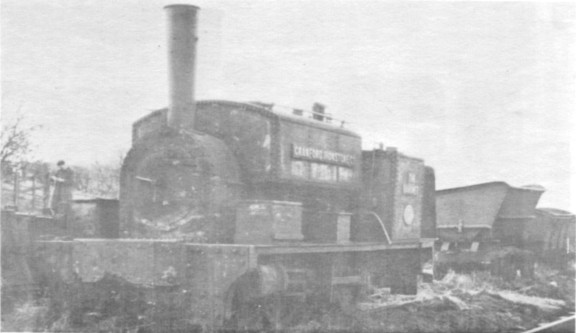
FAVOURITES AT “WALTHAM” ….
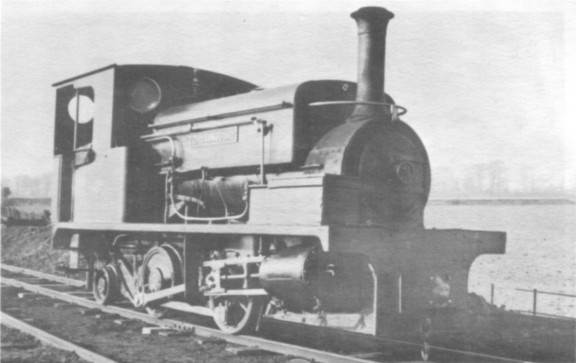
Above DREADNOUGHT (Manning, Wardle 1757 of 1910)
Below
NANTES (Veuve Corpet & L. Louvet 936 of 1903)
(Both photos courtesy
of L.W. Perkins)
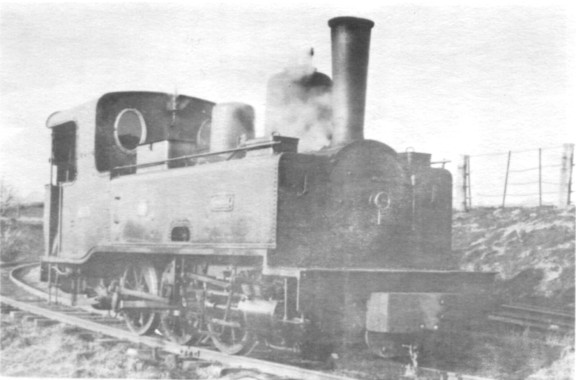
…. AND AT EASTWELL
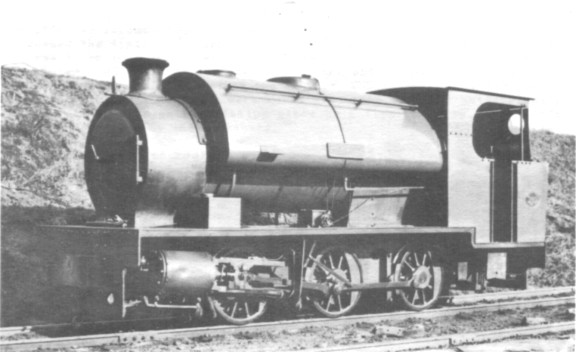
Above BELVOIR (Hunslet 1823 of 1936)
Below UNDERBANK (Peckett 873 of 1900)
(Both photos courtesy of L.W. Perkins)

QUINTETS AT EASTWELL
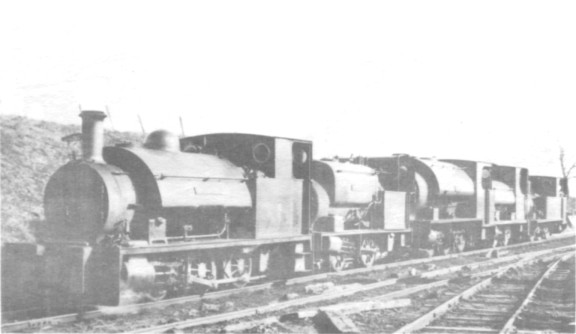
Above Posing for the photographer on 8th March 1953, sleek and shiny. Left to right - PIONEER, LORD GRANBY, BELVOIR, UNDERBANK and NANCY. (Courtesy L.W. Perkins)
Below Awaiting the hammer on 28th August 1960, neglected and unwanted. The wagon stock and - left to right - UNDERBANK, LORD GRANBY, MOUNTAINEER, PIONEER and BELVOIR. (Courtesy R.A Fox)
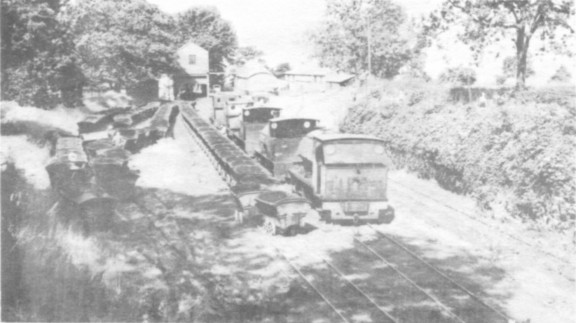
By 1958 two locomotives only were serviceable, PIONEER and NANCY, and these worked the traffic throughout the remaining life of the tramway. LORD GRANBY was taken into the workshops that year and repairs were commenced but not completed. MOUNTAINEER took shelter in the shops also in June 1959 but no work was done on her. The other two engines, UNDERBANK and BELVOIR, which had done no work for some time, were moved about the premises until finally displaced from their rightful resting place by a tipping lorry. They were then left in the open by the workshops.
It had been hoped to replace the 3’0” system by a standard gauge line running from the quarry to the “Exchange Siding” on the B.R. Eaton Branch, as negotiation of the escarpment to the foot of the incline would have been impracticable. This course, however, meant an increase in the freight charge on B.R. of two shillings per ton, because of the longer mileage to Staveley Works. By the time B.R. had reconsidered and reduced the charge by a shilling per ton, the decision had been taken to utilise the existing despatching point, with lorry haulage between it and the quarries. A road for lorries across the field from the Eastwell - Harby road to the tipping dock was completed in September 1959, the new tipping dock being alongside the wagon tippler. The first AEC lorry (877 FAU) arrived later that month and the second (458 FTV) on 20th October. The tramway was then closed for regular use the following day, when Mr. Coy drove PIONEER into the yard for the last time.
The Day Book for Wednesday 21st October 1959 records the event simply as the “last day of steam”, but it was of some significance to the men who had spent a lifetime with the quarries and therefore the tramway, and the locomotives were covered with chalked inscriptions - “Last train E.I.O. Co. 1959” on the rear of NANCY; “My life is at its end” on the side of PIONEER, and others. In the cab of NANCY appeared the following notice:
“Instruction for future use.
(1) Put water in boiler.
(2) Sticks and coal in firebox.
(3) light fire.
(4) And await substance known in 1959 as steam.”
Thenceforward, the tramway was only to be used as a reluctant deputy, but it was decided to keep it intact for the winter in case the lorries had difficulty on the hills - in icy weather, for example. Two lines of loaded tubs were stationed at the top of the incline, which had its usual complement dotted all the way down, so that output could be maintained at a moment’s notice. In the event, no trouble arose with the new arrangements, and on 10th August 1960 the decision was taken to dispense with the tramway. On 15th August NANCY was steamed (PIONEER was to have been used, but was found to have leaky tubes) to marshal the stock in the yard preparatory to clearing the incline and the remaining tubs of ore (some already sprouting weeds) on the following day. The whole proceedings on the 16th were filmed in colour and in black-and-white by Mr. W.A. Camwell, ensuring a permanent record of an historic event - the passing of the last rope-worked ironstone incline in this country.
The full tubs were lowered down the incline in the usual way, with empties coming off at the top alongside. At half-past-two the last full wagon was attached to the cable by Mr. Coy. A garland of wild flowers - freshly picked hawkweed and marjoram from the cutting - was placed on the loaded ore, and the inscription “LAST TRAM 16/8/60. Running 1880 - 1960” chalked on the side of the tub. With no more full wagons going down, empties were detached at the bottom, the last dozen or so being “spragged” and then pushed on to the tippler by hand. At twenty-past-three the last tub was emptied into the B.R. wagon below, and the incline was clear of wagons - a strange sight and, as Mr. Coy put it, “the end of an era”.
Meanwhile, at the summit, NANCY was dispersing from the incline top the empty tubs which were then hauled by a lorry on to the grass verge to await cutting up. The locomotives, which had been put out of the shed whilst these operations were going on, were marshalled in a line extending from the cable house to the bridge - UNDERBANK, LORD GBANBY, MOUNTAINEER, PIONEER and BELVOIR. On the 28th NANCY came out of her lonely shed again, this time to give a farewell trip over the usable portion of the line for the benefit of B.L.C. members who turned up nearly a hundred strong. A convoy of cars and motor-cycles collected, such as had never been seen before at Eastwell. A horde of amateur photographers swarmed round the decaying stock until recalled to the waiting train by a prolonged toot on NANCY’s deep-toned whistle. The train was propelled to the quarry - more photography - NANCY was suitably inscribed “Good-Bye” in chalk - and then back again without a slip, snorting under the bridge below a battery of cameras, back to the yard. Here NANCY went on shed to drop her fire for the last time, and then rejoined her confrères in the open, for the benefit of the photographers. Removable plates were taken off for safe-keeping.
Three months later Ken Cooper described the scene. “This was a farewell visit by me to the two narrow gauge systems and my final photographs at Eastwell were taken when the rays of the late afternoon November sun were almost horizontal, and lighting the general scene with a strange brilliance against an eastern sky of gathering gloom”. Towards the end of the year track-lifting commenced, using road vehicles, and by Christmas had extended from the yard to White Lodge. Two hundred tons of rail went to the Talyllyn Railway, and some went to Middlesbrough. The incline was still intact, and so were the “trains” at the top and foot. When “Eric the Burner” arrived from “Waltham” in January 1961, he commenced operations on the wagons at the incline foot before attending to the stock at the top.
By this time, happily, narrow gauge locomotives were becoming increasingly in demand for preservation, both by established Museums and by private individuals. At first, two-foot gauge exhibits were preferred, but by 1961 the three-foot also came in for consideration, and Eastwell benefited from this wave of enthusiasm, LORD GRANBY was found promise of a home in Leeds Museum by the efforts of the Narrow Gauge Railway Society, and the Company kindly donated her to the Society - even with a brand-new smokebox door intended for THE SCOT but never used. On Friday, 21st April 1961, she was loaded upon a lorry and transported to the Copley Hill store for restoration and storage until the Transport Section of the Leeds Museum is ready. NANCY was purchased by the brothers Stirland, of Watnall in Nottinghamshire, and was taken there by road in the afternoon of Tuesday, 3rd October 1961. Nor was that all; at the instance of the writer, one of the wagons (peculiar to the Staveley group of narrow gauge tramways) was saved, from destruction and again found a home by the Narrow Gauge Railway Society, who took it away on Sunday, 8th April 1962. A dragline had been brought down from the pit and was used to lift the tub on to the “pickup” which had been fitted with boards to take the wheels. Going up the long hill to its new temporary home in Golcar, Mike Swift commented - “We kept half an eye on the “tram” and tried to visualize its effect on the following bus, should it break away”.... Towyn Museum also came in for some small items - Level Crossing notices; the branch signal post; a whistle (from THE SCOT ?); and a pair of ex‑Belvoir tramway plates that had long been at Eastwell. The writer also lugged home a couple of spraggs - one wood and the other steel.
The rest of the tramway equipment went in 1961, with the exception of BELVOIR, which was kept as a possible reserve for Scaldwell Quarries. UNDERBANK was cut up in February to make way for the removal of LORD GRANBY behind her, but after that Mr. Burroughs concentrated on wagons (of which there were about 250 at the closure) and it was not until well into the summer that the two Bagnalls were scrapped, the exact dates being unrecorded.
The wintry scene in January 1962 was a sad one for the enthusiast; about a hundred yards of track, BELVOIR rusting away and with smokebox door yawning open, and the solitary tub isolated in the empty yard beneath the office. Inspection of the route showed that track-lifting had not - as yet - been followed by the orgy of levelling that had taken place at “Waltham”, and all cuttings and embankments remained as before, sharply etched on the snow-mantled countryside. The writer, for one, hopes they will remain so as a gentle reminder of the little trains that could not, by any stretch of the imagination, be regarded as other than an asset to the rural scene.
(POSTSCRIPT. A visit by the Editor to Eastwell early in September 1962 was most disheartening for it revealed the many changes effected during the summer. Only the blacksmith’s shop (due to be dismantled), stores and office building were still standing. BELVOIR, alas, is no more for, after a session at Pilton and Desborough, “Eric the Burner” came to Eastwell and scrapped her in July 1962. The cutting is being filled in, and all unwanted land is being returned to agriculture as soon as possible. Another dumper lorry (939 KTV) had arrived and a garage to hold all three is being built. The lorries are numbered 1, 2 and 3, but the garage wall in front of their “stands” will carry a worksplate and nameplate off MOUNTAINEER, PIONEER and UNDERBANK. All except the worksplate off PIONEER[1] had already been securely affixed; they will, provide a lasting memorial of the lorries’ more illustrious forebears. - Ed.).
1 one has been officially presented to our Chairman.